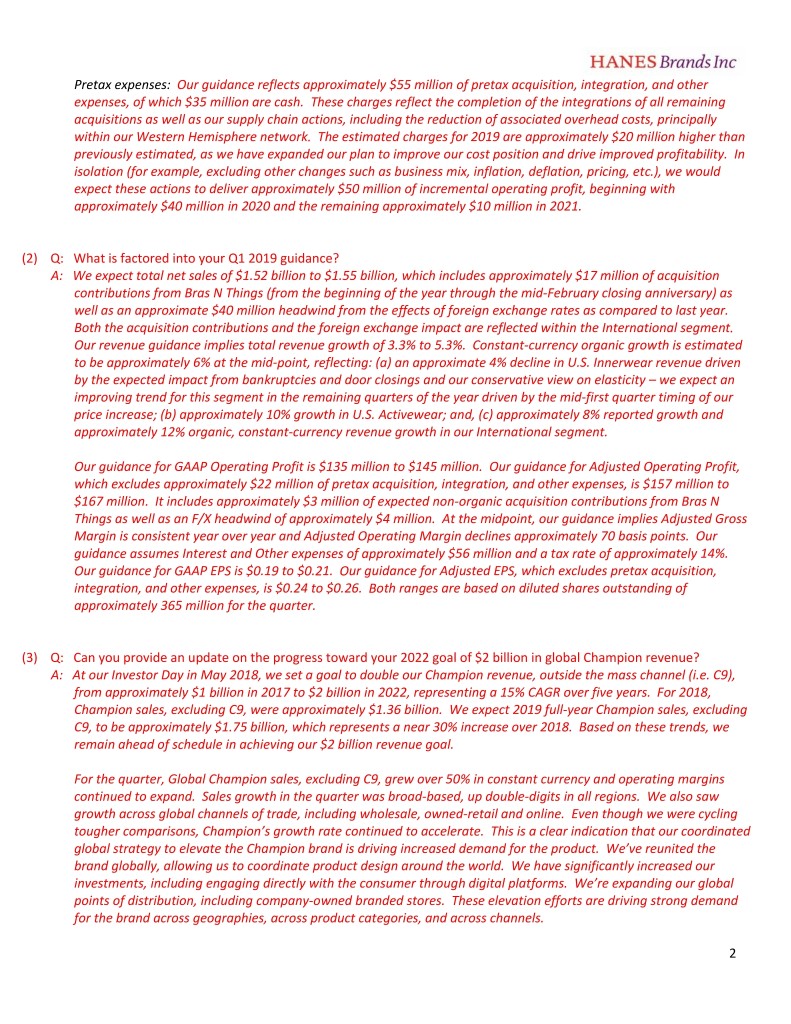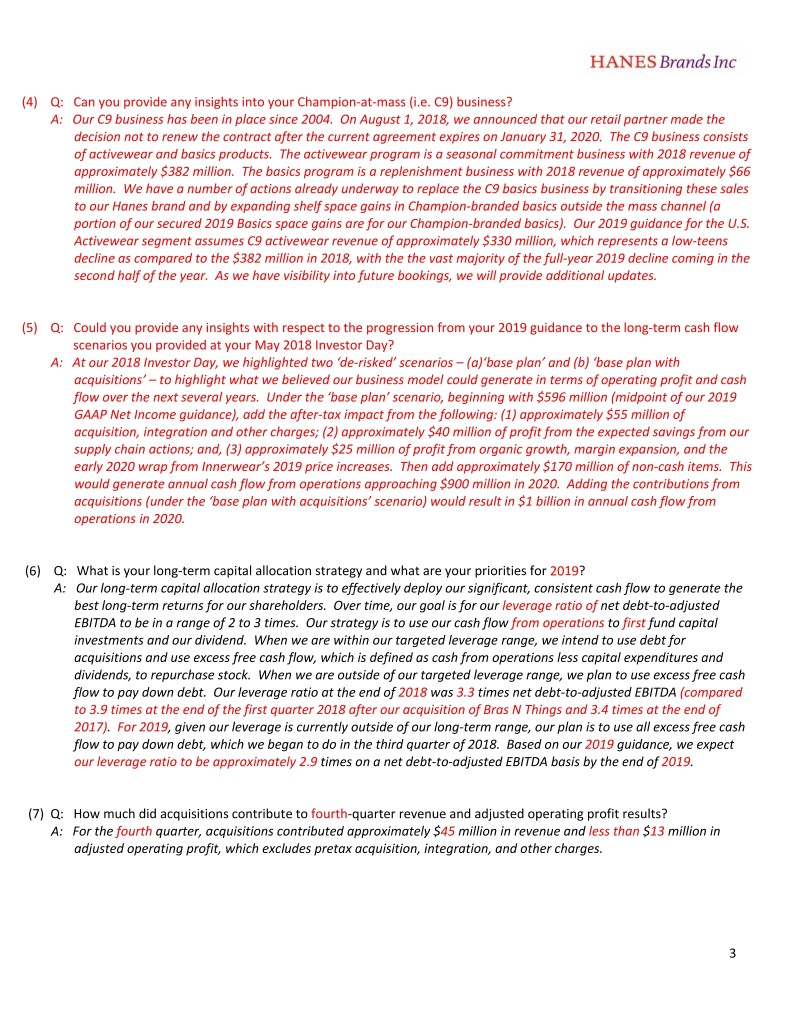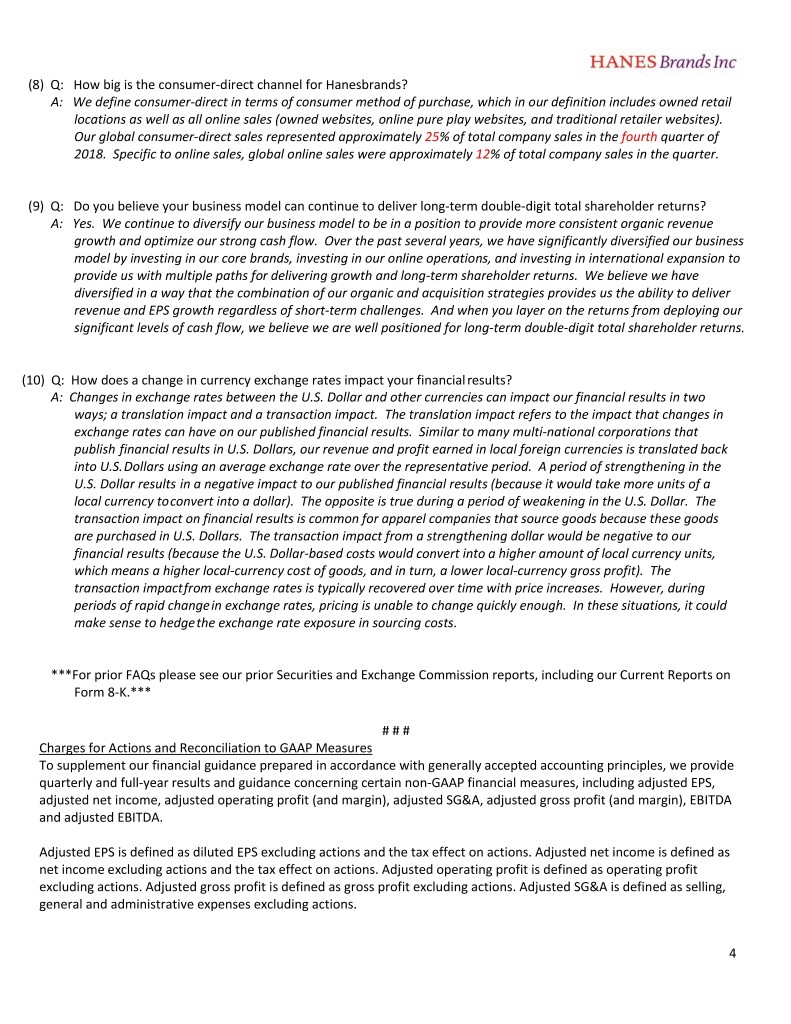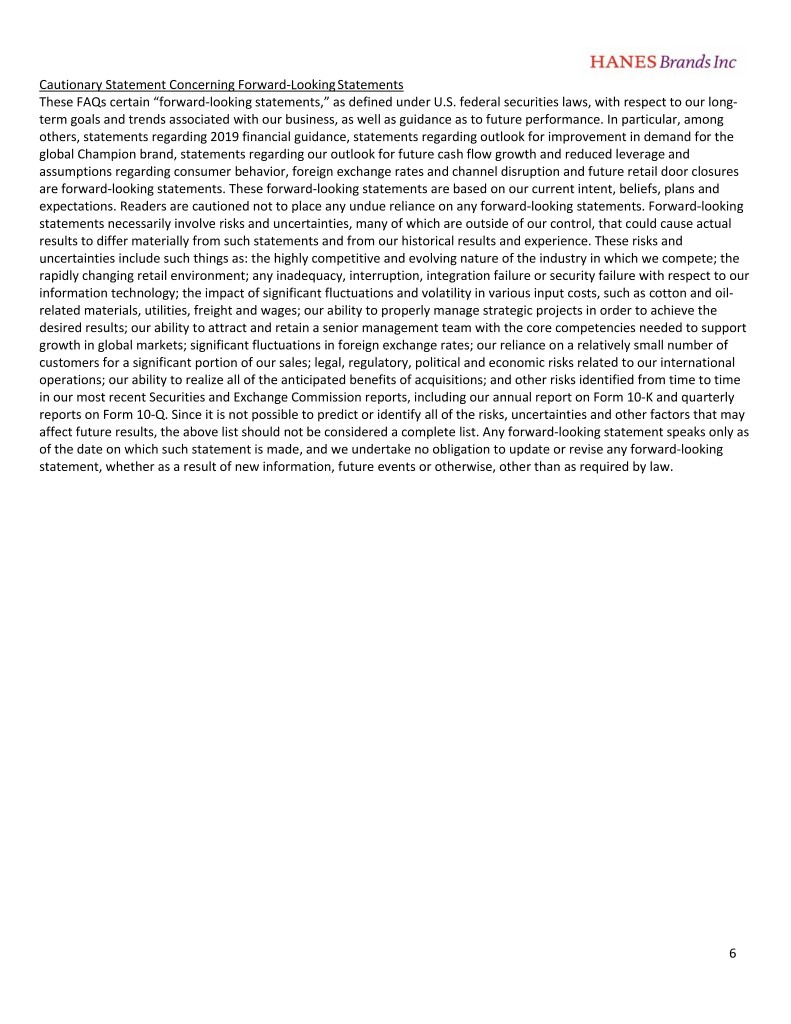
Hanesbrands FAQs Updated February 7, 2019 – New or updated information is in red General and Current Period FAQs (Guidance comments as of February 7, 2019) (1) Q: What is factored into your full‐year 2019 guidance? A: Revenue: Our full‐year revenue guidance of $6.885 billion to $6.985 billion represents low‐single‐digit growth year over year. It includes the following assumptions: (a) approximately $17 million of acquisition contributions from Bras N Things (from the beginning of the year through the mid‐February closing anniversary – reflected in the International segment); (b) F/X headwind of approximately $60 million, with the vast majority impacting the first quarter (reflected in the International segment); and, (c) organic constant‐currency growth of approximately 2.5% at the midpoint. Using the midpoint, by segment, we expect U.S. Innerwear revenue to be down approximately 2% for the full‐year as our conservative outlook with respect to the impact from bankruptcies and door closings, particularly within the mid‐ tier and department store channel, and our conservative view on elasticity more than offsets Basics space gains, price increases and the initial traction of our U.S. Intimates revitalization efforts. U.S. Activewear revenue is expected to be up approximately 2.5% for the year reflecting: (a) double‐digit growth in each quarter for Champion, excluding the mass channel (i.e. C9); (b) C9 activewear revenue of approximately $330 million, which represents a low‐teens decline compared to 2018; and, (c) a decline in our American Casualwear business as we continue to shift this business into higher‐margin products. The vast majority of the full‐year decline in both C9 and American Casualwear is expected in the second half of the year. The mix impact of these assumptions should yield significant margin improvement in our U.S. Activewear segment for the year, with segment margin expansion in each quarter. For the full year, our International segment is expected to be up approximately 6% on a reported basis. On an organic, constant‐currency basis, our guidance reflects approximately 8% growth driven by our International Champion businesses as well as our innerwear businesses in Asia, Australia and the Americas, which is expected to be partially offset by the impact from macro headwinds on our European innerwear business. Operating Profit (GAAP and Adjusted): Our full‐year Adjusted Operating Profit guidance of $955 million to $985 million excludes all pretax acquisition, integration, and other charges. It includes approximately $3 million of expected non‐organic acquisition contributions from Bras N Things as well as an F/X headwind of approximately $7 million. Our guidance implies approximately 50 basis points of Adjusted Gross Margin expansion and approximately 10 basis points of Adjusted Operating Margin expansion year over year as we increase investment to support our growth initiatives (for example, brand support). Our full‐year GAAP Operating Profit guidance of $900 million to $930 million incorporates our Adjusted Operating Profit guidance as well as our assumption of approximately $55 million of pretax acquisition, integration, and other charges. Interest/Other Expenses and Tax Rate: Our guidance assumes approximately $224 million of Interest and Other expenses as well as a tax rate of approximately 14%. EPS (GAAP and Adjusted): At the mid‐point, our guidance implies full‐year GAAP and Adjusted Net Income of approximately $596 million and $643 million, respectively. Our full‐year GAAP EPS guidance is $1.59 to $1.67 and our Adjusted EPS guidance, which excludes all pretax acquisition, integration, and other charges, is $1.72 to $1.80. Both ranges are based on diluted shares outstanding of approximately 366 million. Cash flow from operations: Our full‐year cash flow from operations guidance is $700 million to $800 million. Consistent with our normal seasonality, we expect cash flow from operations to be a use in the first half. Our capital expenditure guidance is $90 million to $100 million. 1

Pretax expenses: Our guidance reflects approximately $55 million of pretax acquisition, integration, and other expenses, of which $35 million are cash. These charges reflect the completion of the integrations of all remaining acquisitions as well as our supply chain actions, including the reduction of associated overhead costs, principally within our Western Hemisphere network. The estimated charges for 2019 are approximately $20 million higher than previously estimated, as we have expanded our plan to improve our cost position and drive improved profitability. In isolation (for example, excluding other changes such as business mix, inflation, deflation, pricing, etc.), we would expect these actions to deliver approximately $50 million of incremental operating profit, beginning with approximately $40 million in 2020 and the remaining approximately $10 million in 2021. (2) Q: What is factored into your Q1 2019 guidance? A: We expect total net sales of $1.52 billion to $1.55 billion, which includes approximately $17 million of acquisition contributions from Bras N Things (from the beginning of the year through the mid‐February closing anniversary) as well as an approximate $40 million headwind from the effects of foreign exchange rates as compared to last year. Both the acquisition contributions and the foreign exchange impact are reflected within the International segment. Our revenue guidance implies total revenue growth of 3.3% to 5.3%. Constant‐currency organic growth is estimated to be approximately 6% at the mid‐point, reflecting: (a) an approximate 4% decline in U.S. Innerwear revenue driven by the expected impact from bankruptcies and door closings and our conservative view on elasticity – we expect an improving trend for this segment in the remaining quarters of the year driven by the mid‐first quarter timing of our price increase; (b) approximately 10% growth in U.S. Activewear; and, (c) approximately 8% reported growth and approximately 12% organic, constant‐currency revenue growth in our International segment. Our guidance for GAAP Operating Profit is $135 million to $145 million. Our guidance for Adjusted Operating Profit, which excludes approximately $22 million of pretax acquisition, integration, and other expenses, is $157 million to $167 million. It includes approximately $3 million of expected non‐organic acquisition contributions from Bras N Things as well as an F/X headwind of approximately $4 million. At the midpoint, our guidance implies Adjusted Gross Margin is consistent year over year and Adjusted Operating Margin declines approximately 70 basis points. Our guidance assumes Interest and Other expenses of approximately $56 million and a tax rate of approximately 14%. Our guidance for GAAP EPS is $0.19 to $0.21. Our guidance for Adjusted EPS, which excludes pretax acquisition, integration, and other expenses, is $0.24 to $0.26. Both ranges are based on diluted shares outstanding of approximately 365 million for the quarter. (3) Q: Can you provide an update on the progress toward your 2022 goal of $2 billion in global Champion revenue? A: At our Investor Day in May 2018, we set a goal to double our Champion revenue, outside the mass channel (i.e. C9), from approximately $1 billion in 2017 to $2 billion in 2022, representing a 15% CAGR over five years. For 2018, Champion sales, excluding C9, were approximately $1.36 billion. We expect 2019 full‐year Champion sales, excluding C9, to be approximately $1.75 billion, which represents a near 30% increase over 2018. Based on these trends, we remain ahead of schedule in achieving our $2 billion revenue goal. For the quarter, Global Champion sales, excluding C9, grew over 50% in constant currency and operating margins continued to expand. Sales growth in the quarter was broad‐based, up double‐digits in all regions. We also saw growth across global channels of trade, including wholesale, owned‐retail and online. Even though we were cycling tougher comparisons, Champion’s growth rate continued to accelerate. This is a clear indication that our coordinated global strategy to elevate the Champion brand is driving increased demand for the product. We’ve reunited the brand globally, allowing us to coordinate product design around the world. We have significantly increased our investments, including engaging directly with the consumer through digital platforms. We’re expanding our global points of distribution, including company‐owned branded stores. These elevation efforts are driving strong demand for the brand across geographies, across product categories, and across channels. 2

(4) Q: Can you provide any insights into your Champion‐at‐mass (i.e. C9) business? A: Our C9 business has been in place since 2004. On August 1, 2018, we announced that our retail partner made the decision not to renew the contract after the current agreement expires on January 31, 2020. The C9 business consists of activewear and basics products. The activewear program is a seasonal commitment business with 2018 revenue of approximately $382 million. The basics program is a replenishment business with 2018 revenue of approximately $66 million. We have a number of actions already underway to replace the C9 basics business by transitioning these sales to our Hanes brand and by expanding shelf space gains in Champion‐branded basics outside the mass channel (a portion of our secured 2019 Basics space gains are for our Champion‐branded basics). Our 2019 guidance for the U.S. Activewear segment assumes C9 activewear revenue of approximately $330 million, which represents a low‐teens decline as compared to the $382 million in 2018, with the the vast majority of the full‐year 2019 decline coming in the second half of the year. As we have visibility into future bookings, we will provide additional updates. (5) Q: Could you provide any insights with respect to the progression from your 2019 guidance to the long‐term cash flow scenarios you provided at your May 2018 Investor Day? A: At our 2018 Investor Day, we highlighted two ‘de‐risked’ scenarios – (a)‘base plan’ and (b) ‘base plan with acquisitions’ – to highlight what we believed our business model could generate in terms of operating profit and cash flow over the next several years. Under the ‘base plan’ scenario, beginning with $596 million (midpoint of our 2019 GAAP Net Income guidance), add the after‐tax impact from the following: (1) approximately $55 million of acquisition, integration and other charges; (2) approximately $40 million of profit from the expected savings from our supply chain actions; and, (3) approximately $25 million of profit from organic growth, margin expansion, and the early 2020 wrap from Innerwear’s 2019 price increases. Then add approximately $170 million of non‐cash items. This would generate annual cash flow from operations approaching $900 million in 2020. Adding the contributions from acquisitions (under the ‘base plan with acquisitions’ scenario) would result in $1 billion in annual cash flow from operations in 2020. (6) Q: What is your long‐term capital allocation strategy and what are your priorities for 2019? A: Our long‐term capital allocation strategy is to effectively deploy our significant, consistent cash flow to generate the best long‐term returns for our shareholders. Over time, our goal is for our leverage ratio of net debt‐to‐adjusted EBITDA to be in a range of 2 to 3 times. Our strategy is to use our cash flow from operations to first fund capital investments and our dividend. When we are within our targeted leverage range, we intend to use debt for acquisitions and use excess free cash flow, which is defined as cash from operations less capital expenditures and dividends, to repurchase stock. When we are outside of our targeted leverage range, we plan to use excess free cash flow to pay down debt. Our leverage ratio at the end of 2018 was 3.3 times net debt‐to‐adjusted EBITDA (compared to 3.9 times at the end of the first quarter 2018 after our acquisition of Bras N Things and 3.4 times at the end of 2017). For 2019, given our leverage is currently outside of our long‐term range, our plan is to use all excess free cash flow to pay down debt, which we began to do in the third quarter of 2018. Based on our 2019 guidance, we expect our leverage ratio to be approximately 2.9 times on a net debt‐to‐adjusted EBITDA basis by the end of 2019. (7) Q: How much did acquisitions contribute to fourth‐quarter revenue and adjusted operating profit results? A: For the fourth quarter, acquisitions contributed approximately $45 million in revenue and less than $13 million in adjusted operating profit, which excludes pretax acquisition, integration, and other charges. 3

(8) Q: How big is the consumer‐direct channel for Hanesbrands? A: We define consumer‐direct in terms of consumer method of purchase, which in our definition includes owned retail locations as well as all online sales (owned websites, online pure play websites, and traditional retailer websites). Our global consumer‐direct sales represented approximately 25% of total company sales in the fourth quarter of 2018. Specific to online sales, global online sales were approximately 12% of total company sales in the quarter. (9) Q: Do you believe your business model can continue to deliver long‐term double‐digit total shareholder returns? A: Yes. We continue to diversify our business model to be in a position to provide more consistent organic revenue growth and optimize our strong cash flow. Over the past several years, we have significantly diversified our business model by investing in our core brands, investing in our online operations, and investing in international expansion to provide us with multiple paths for delivering growth and long‐term shareholder returns. We believe we have diversified in a way that the combination of our organic and acquisition strategies provides us the ability to deliver revenue and EPS growth regardless of short‐term challenges. And when you layer on the returns from deploying our significant levels of cash flow, we believe we are well positioned for long‐term double‐digit total shareholder returns. (10) Q: How does a change in currency exchange rates impact your financial results? A: Changes in exchange rates between the U.S. Dollar and other currencies can impact our financial results in two ways; a translation impact and a transaction impact. The translation impact refers to the impact that changes in exchange rates can have on our published financial results. Similar to many multi‐national corporations that publish financial results in U.S. Dollars, our revenue and profit earned in local foreign currencies is translated back into U.S. Dollars using an average exchange rate over the representative period. A period of strengthening in the U.S. Dollar results in a negative impact to our published financial results (because it would take more units of a local currency to convert into a dollar). The opposite is true during a period of weakening in the U.S. Dollar. The transaction impact on financial results is common for apparel companies that source goods because these goods are purchased in U.S. Dollars. The transaction impact from a strengthening dollar would be negative to our financial results (because the U.S. Dollar‐based costs would convert into a higher amount of local currency units, which means a higher local‐currency cost of goods, and in turn, a lower local‐currency gross profit). The transaction impact from exchange rates is typically recovered over time with price increases. However, during periods of rapid change in exchange rates, pricing is unable to change quickly enough. In these situations, it could make sense to hedge the exchange rate exposure in sourcing costs. ***For prior FAQs please see our prior Securities and Exchange Commission reports, including our Current Reports on Form 8‐K.*** # # # Charges for Actions and Reconciliation to GAAP Measures To supplement our financial guidance prepared in accordance with generally accepted accounting principles, we provide quarterly and full‐year results and guidance concerning certain non‐GAAP financial measures, including adjusted EPS, adjusted net income, adjusted operating profit (and margin), adjusted SG&A, adjusted gross profit (and margin), EBITDA and adjusted EBITDA. Adjusted EPS is defined as diluted EPS excluding actions and the tax effect on actions. Adjusted net income is defined as net income excluding actions and the tax effect on actions. Adjusted operating profit is defined as operating profit excluding actions. Adjusted gross profit is defined as gross profit excluding actions. Adjusted SG&A is defined as selling, general and administrative expenses excluding actions. 4

Charges for actions taken in 2017 primarily represent: adjustments for U.S. tax reform; acquisition‐related and integration costs related to Hanes Europe Innerwear, Hanes Australasia, Champion Europe and Knights Apparel; debt refinancing; an earn‐out payment related to the purchase of Champion Europe; and other charges primarily related to disruptions of supply chain operations due to natural disasters. Charges for actions taken in 2018 primarily represent acquisition and integration costs related to Hanes Europe Innerwear, Hanes Australasia, Champion Europe, Alternative Apparel and Bras N Things, and other costs related to supply chain network changes. Charges for actions expected to be taken in 2019 primarily represent supply chain network changes and overhead reduction as well as completion of outstanding acquisition integration. Acquisition and integration costs include legal fees, consulting fees, bank fees, severance costs, certain purchase accounting items, facility closures, inventory write‐offs, information technology integration costs and similar charges. While these costs are not operational in nature and are not expected to continue for any singular transaction on an ongoing basis, similar types of costs, expenses and charges have occurred in prior periods and may recur in future periods depending upon acquisition activity. We have chosen to present these non‐GAAP measures to investors to enable additional analyses of past, present and future operating performance and as a supplemental means of evaluating operations absent the effect of acquisitions and other actions. We believe these non‐GAAP measures provide management and investors with valuable supplemental information for analyzing the operating performance of the company’s ongoing business during each period presented without giving effect to costs associated with the execution and integration of any of the aforementioned actions taken. In addition to these non‐GAAP measures, we have chosen to present EBITDA and adjusted EBITDA to investors because we consider it to be an important supplemental means of evaluating operating performance. EBITDA is defined as earnings before interest, taxes, depreciation and amortization. Adjusted EBITDA is defined as EBITDA excluding actions and stock compensation expense. We believe that EBITDA and adjusted EBITDA are frequently used by securities analysts, investors and other interested parties in the evaluation of companies in the industry, and management uses EBITDA and adjusted EBITDA for planning purposes in connection with setting our capital allocation strategy. EBITDA and Adjusted EBITDA should not, however, be considered as measures of discretionary cash available to invest in the growth of the business. We are a global company that reports financial information in U.S. dollars in accordance with GAAP. As a supplement to our reported operating results, we also present constant currency financial information, which is a non‐GAAP financial measure that excludes the impact of translating foreign currencies into U.S. dollars. We use constant currency information to provide a framework to assess how the business performed excluding the effects of changes in the rates used to calculate foreign currency translation. We believe this information is useful to management and investors to facilitate comparison of operating results and better identify trends in our businesses. To calculate foreign currency translation on a constant currency basis, operating results for the current year period for entities reporting in currencies other than the U.S. dollar are translated into U.S. dollars at the average exchange rates in effect during the comparable period of the prior year (rather than the actual exchange rates in effect during the current year period). Non‐GAAP financial measures have limitations as analytical tools and should not be considered in isolation or as an alternative to, or substitute for, financial results prepared in accordance with GAAP. Further, the non‐GAAP measures presented may be different from non‐GAAP measures with similar or identical names presented by other companies. See our press release dated February 7, 2019 to reconcile quarterly and full‐year non‐GAAP performance measures to the most directly comparable GAAP measure. A copy of the press release is available at www.Hanes.com/investors. 5

Cautionary Statement Concerning Forward‐Looking Statements These FAQs certain “forward‐looking statements,” as defined under U.S. federal securities laws, with respect to our long‐ term goals and trends associated with our business, as well as guidance as to future performance. In particular, among others, statements regarding 2019 financial guidance, statements regarding outlook for improvement in demand for the global Champion brand, statements regarding our outlook for future cash flow growth and reduced leverage and assumptions regarding consumer behavior, foreign exchange rates and channel disruption and future retail door closures are forward‐looking statements. These forward‐looking statements are based on our current intent, beliefs, plans and expectations. Readers are cautioned not to place any undue reliance on any forward‐looking statements. Forward‐looking statements necessarily involve risks and uncertainties, many of which are outside of our control, that could cause actual results to differ materially from such statements and from our historical results and experience. These risks and uncertainties include such things as: the highly competitive and evolving nature of the industry in which we compete; the rapidly changing retail environment; any inadequacy, interruption, integration failure or security failure with respect to our information technology; the impact of significant fluctuations and volatility in various input costs, such as cotton and oil‐ related materials, utilities, freight and wages; our ability to properly manage strategic projects in order to achieve the desired results; our ability to attract and retain a senior management team with the core competencies needed to support growth in global markets; significant fluctuations in foreign exchange rates; our reliance on a relatively small number of customers for a significant portion of our sales; legal, regulatory, political and economic risks related to our international operations; our ability to realize all of the anticipated benefits of acquisitions; and other risks identified from time to time in our most recent Securities and Exchange Commission reports, including our annual report on Form 10‐K and quarterly reports on Form 10‐Q. Since it is not possible to predict or identify all of the risks, uncertainties and other factors that may affect future results, the above list should not be considered a complete list. Any forward‐looking statement speaks only as of the date on which such statement is made, and we undertake no obligation to update or revise any forward‐looking statement, whether as a result of new information, future events or otherwise, other than as required by law. 6





